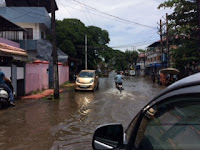When we arrived in Kerala at
the end of June we knew it was the monsoon season but we really had no idea
what to expect. We have since discovered that monsoon does not mean day long
periods of rain but intermittent heavy downpours followed by hot sun, although
there can be longer periods leading to local flooding.
Flooding in Kochi Life goes on despite the flood
The weather in Kerala falls into three
distinct seasons. Winter is the peak tourist season from December to February
when the weather is relatively cool and dry. From March to May the summer
season is very hot and humid. In between is the monsoon season from May to
November which divides between the South-West Monsoon and North-East Monsoon.
The South-West Monsoon is the main rainy season. It begins by the end of
May or early June with the onset of the rain bearing winds coming off the
Arabian Sea from the southwest, and lasts until the end of September. During
these months there are periods of torrential rain due to the presence of the
fort like Western Ghats that flank the east of the state preventing the winds from
progressing further into the central and eastern states. As a result almost 85%
of the rains received in Kerala are contributed by the monsoon with the slopes
of the Ghats recording the highest rainfall.
Not the weather for boating Only option to take shelter
The North East Monsoon, also known as the Retreating or Reverse
Monsoon, hits Kerala as rain clouds coming off the Bay of Bengal pass
through the Palakkad Gap in the Western Ghats. These rains are in the months of October and
November and can last until December. Heavy afternoon rains accompanied by
thunder and lightning is the main characteristic of this season. Days are warm
and humid but there is not much variation in temperature which normally ranges
from 28° to 32°C (82° to 90°F) on the seaward plains.
Short sharp shower Lightening turns night to day
Winter in Kerala starts with the end of the northeast monsoons during
the later part of November and lasts until the middle of February. During this
season temperature is comparatively low and witnesses the lowest amount of
rainfall.
Toward the end of February temperatures start climbing and this marks
the beginning of Kerala’s summer lasting from March until the onset of the
monsoon. Relatively higher temperature, low rainfall and slightly humid weather
are the summer’s characteristics.
Western Ghats in cloud The Ghats at Wayanad
In contrast to other Indian states where temperature can soar to over
40°C, summers in Kerala are cool and pleasant thanks to the Western Ghats which
prevent the dry northern winds from entering the state and the Arabian Sea offering
cool breezes. Despite this somewhat erratic rains accompanied by lightning and
thunder is a feature of this season.
Kerala
does not have incessant rains that stop all activity. It generally rains for a
few hours with sunny interludes. Occasionally the rains might stretch on for a
few days but sunshine is never far away. It is claimed that Monsoon is the best
season for rejuvenation as during the Monsoon season the atmosphere remains
dust-free and cool, opening the pores of the body to the maximum.
Our experience so far is that the monsoon at worst floods our balcony and at best keeps us indoors – but we keep in mind that winter is on its way!
Our experience so far is that the monsoon at worst floods our balcony and at best keeps us indoors – but we keep in mind that winter is on its way!










No comments:
Post a Comment